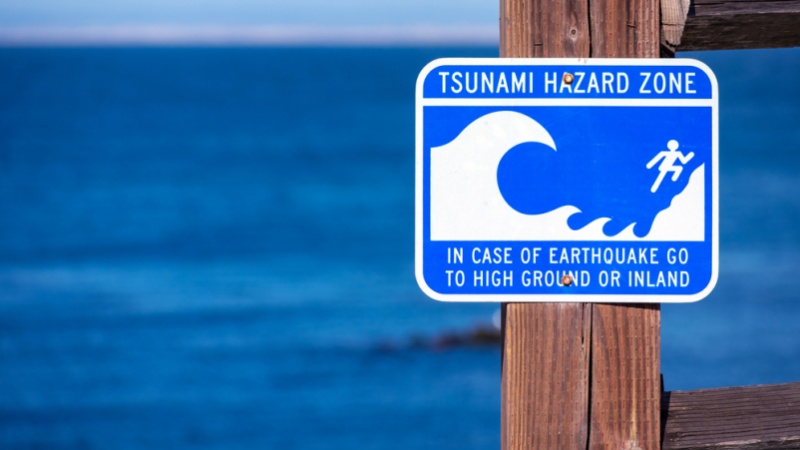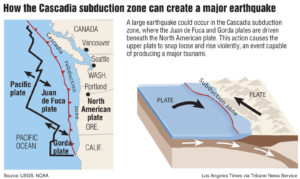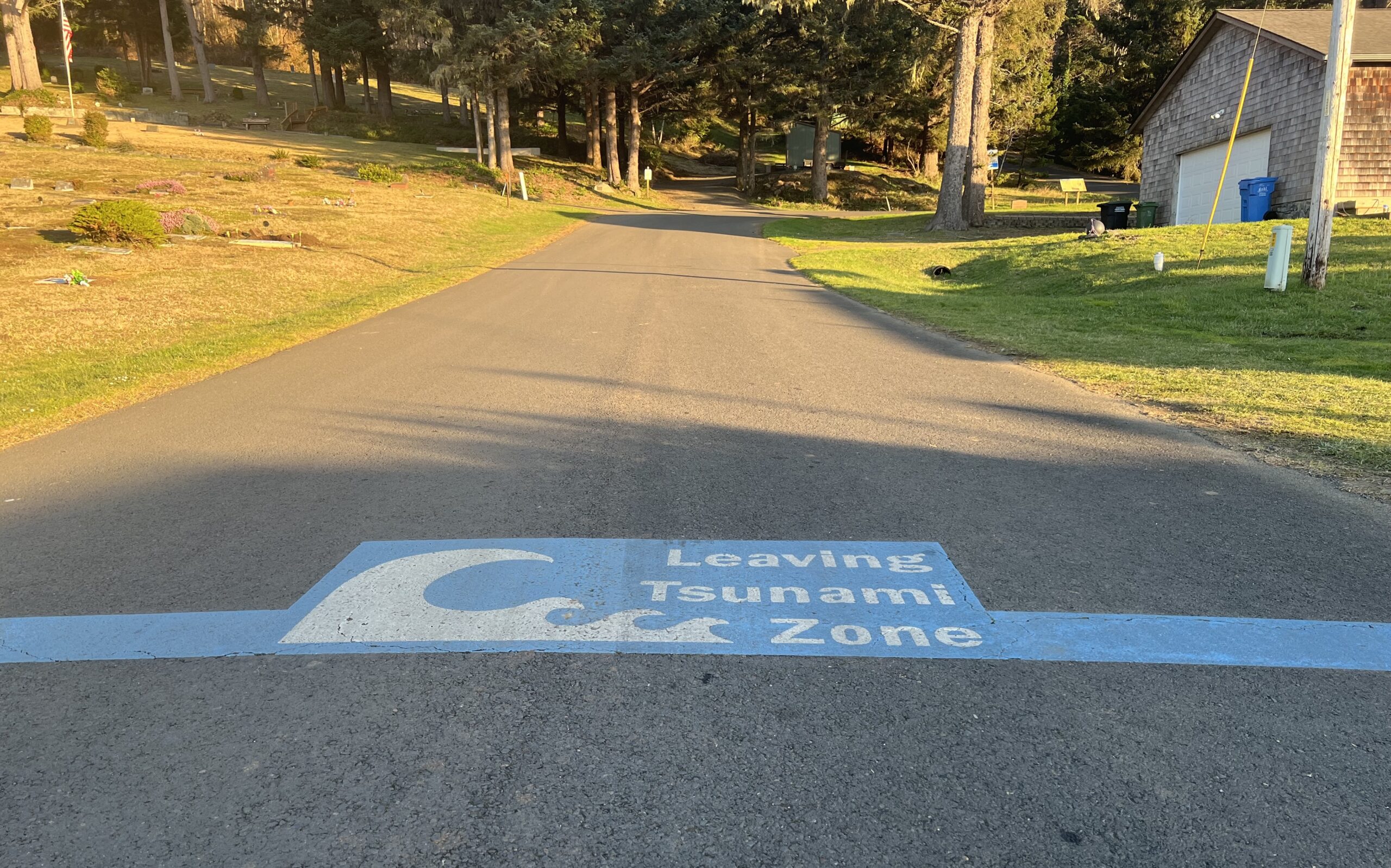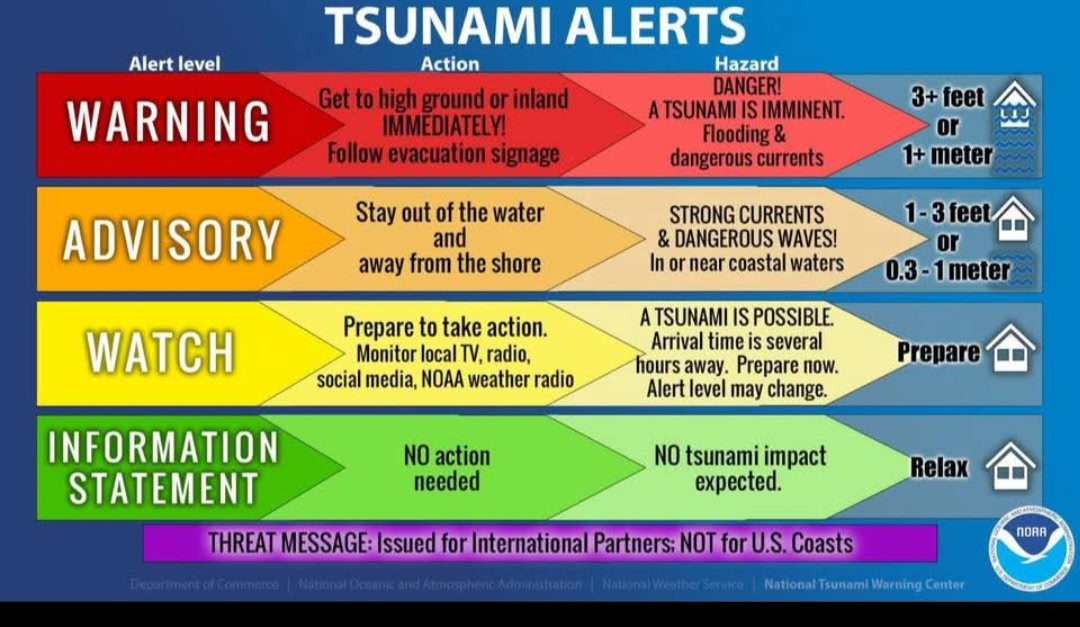
By the Lincoln Chronicle
The U.S. Geological Survey sent its first public notice of an 8.8 magnitude earthquake off Russia’s far eastern coast late Tuesday afternoon and soon emergency operation centers along the Oregon coast were warning the public of the potential for a tsunami Tuesday night.
The Lincoln County Sheriff’s emergency services put its operations center into action about 5:20 p.m. Tuesday and sent its first advisory 30 minutes later. Some 16 hours later it cancelled the tsunami notices after the earthquake nearly 4,000 miles away proved to have had little effect on most of the Oregon and Washington coasts.
Here is a roundup from experts on potential reasons why the West Coast was spared — this time and why there was little effect on the Oregon and Washington coastlines.

The answers are nuanced, scientists told the Seattle Times, but the simple explanation might break down to good luck in the location and timing of the earthquake. All sorts of little geometric details between Russia and the West Coast mean the waves diffused significantly when they arrived to the West Coast, said Jim Thomson, an oceanographer at the University of Washington.
Part of that is the distance. Waves lose strength over time and large expanses. But another part of that is the underwater topography, or bathymetry.
Underwater mountains, dips, curves and plateaus all affect how the waves travel over hundreds or thousands of miles. Generally, the more obstacles in the way, the weaker the waves will become.
On the opposite end of the spectrum, the bathymetry can also make the waves worse. Thomson mentioned the Indian Ocean tsunami in 2004, which killed nearly a quarter million people and left a trail of devastation throughout the region. Those particular waves hit shallower waters quickly – called shoaling — which slows them down but also juts them to higher elevations.
But this week’s tsunami doesn’t appear to have encountered those conditions along the West Coast, Thomson said.
Wave energy from earthquakes also isn’t spread out evenly, Diego Arcas, a tsunami modeler with UW told The Times. The energy is effectively beamed out in different directions, each beam dictated by the geography and other conditions of the earthquake area. If you’re not in the path of those “beams,” the waves won’t be as large, Arcas said.
If the bathymetry and angle of approach combined to diffuse the tsunami across the Pacific Ocean, so did the timing. Waves 1 to 2 feet above normal waves reached the Oregon coast an hour after low tides. So even at their highest point, the tsunami remained comfortably below the daily high-water mark.
The Washington Post said it’s also possible that the earthquake itself, although powerful, may have contributed to a milder tsunami. U.S. Geological Survey modeling suggests the land shifted by 20 to 30 feet along a roughly 300-mile stretch of fault, said Diego Melgar, director of the Cascadia Region Earthquake Science Center at the University of Oregon. These sorts of variations in fault movement can be the difference between relatively small tsunamis and disastrous ones, he told the Post.
For instance, the 2011 earthquake that triggered a nuclear crisis in Japan shifted the land by as much as 150 feet across a similarly long stretch of fault line, creating tsunami waves that were as high as 100 feet locally. It also caused millions of dollars in damage in Crescent City, just south of the Oregon border, and swept one person away.
Again this week, Crescent City’s harbor suffered an estimated $1 million damage from tsunami waves, SF Gate reported. Crescent City recorded the highest tsunami waves in the continental U.S. — up to 4 feet — with powerful surges arriving just before dawn, lifting docks off their pilings and slamming the harbor. The reason, SF Gate reported, is that offshore topography funnels wave energy straight into Crescent City’s harbor.
Melgar told the New York Times that Tuesday’s earthquake had an estimated magnitude of 8.7 or 8.8 on the scale scientists use to measure the strength of earthquakes. Catastrophic tsunamis in the past, including a wave that struck Indonesia in 2004 and another that hit Japan in 2011, were about a magnitude 9 – which possesses about 10 times as much energy as a magnitude 8.7 event.
More likely than not, this earthquake just wasn’t big enough to create a catastrophic wave. “Don’t get me wrong, it’s still huge,” Melgar said. “But those in 2004 and 2011 were behemoths.”

Lincoln County response and tips
The Lincoln County Sheriff’s office said it sent tsunami alerts to 19,207 accounts people have set up through its Everbridge system. Anyone can create a Lincoln Alerts account or update their existing one using this link: member.everbridge.net/892807736721689/new
Check this link for information on creating an account: Lincoln Alerts – Emergency Notifications & Community Information | Lincoln County, OR
A few quick tips:
- Make sure each person in your household has their own account with their own phone number and email. This ensures they get the notices directly.
- Add your home and work addresses (and any other addresses you frequent). This helps during times such as when there are evacuations in only some parts of Lincoln County.
- To receive text messages, make sure to add a cell phone number to the “SMS Text #” field as one of the contact fields.
- Bookmark this page to view sent messages and local alerts (no account needed): member.everbridge.net/892807736721689/notify

A watch, advisory, and warning?
Watch: Is used when the risk of a hazardous weather or another event has increased significantly, but its occurrence, location or timing is still uncertain. A watch is intended to provide enough time for people in the potentially impacted areas to set their plans in motion.
Advisory: Issued when a hazardous weather or another event is occurring, imminent or likely. Advisories are used for less serious conditions than warnings, but still cause significant inconvenience and if caution is not exercised, could lead to situations that may threaten life or property.
Warning: Issued when hazardous weather or events are occurring, imminent, or likely. People in the affected area need to take protective action when a warning is issued.
Distant versus local tsunami?
A distant tsunami, such as the one Tuesday evening, is caused by an earthquake or other event not in the area. This means there is time for responders to get information, assess the situation, and get information out to impacted areas, including information on if people need to evacuate.
A local tsunami is caused by a local earthquake or event. With a local tsunami, the earthquake is the notification that people need to evacuate to higher ground. There is not time for local responders to get information out to the affected areas. If you are ever on the Oregon Coast and feel the ground shake, evacuate to higher ground.
Tsunami inundation zones
Www.Nanoos.org has an interactive map where people can enter any address and see what areas are in the known distant and local tsunami inundation zones. Review NVS Tsunami Evacuation Zones to learn what tsunami evacuation zones your home, work, school, and other areas you frequent are in.
More about tsunamis
- Some impacts may continue for many hours to days after arrival of the first wave;
- The first wave may not be the largest so later waves may be larger;
- Each wave may last 5 to 45 minutes as a wave encroaches and recedes;
- Coasts facing all directions are threatened because the waves can wrap around islands and headlands and into bays;
- A rapidly receding or receded shoreline, unusual waves and sounds, and strong currents are signs of a tsunami; and
- The tsunami may appear as water moving rapidly out to sea, a gentle rising tide like flood with no breaking wave, as a series of breaking waves, or a frothy wall of water.
What can you do to prepare?
Stay updated with current information and alerts, including:
- National Weather Service: www.weather.gov/
- Tsunami.gov: tsunami.gov/
- Sign up for or update existing Lincoln County alert accounts to receive messages directly: member.everbridge.net/892807736721689/new;
- View sent messages and local alerts: member.everbridge.net/892807736721689/notif
- Lincoln County Sheriff’s Office Media Releases – FlashAlert: flashalert.net/id/LCSO
Make an emergency plan by:
- Talking with family and friends about what you will do, including if you’re not together during an emergency;
- Practicing your plan at different times and on different days. What will you do if you are at home, work, school, or another location?
- Planning to check on your neighbors or vulnerable community members and offer assistance if possible;
- Creating an emergency kit or update an existing one.





















After billions of dollars of funding, what are we really getting for our money? A good guess, an estimate, scientific certainty, no we didn’t even get a close estimate. Again, if you cry wolf all the time, then no one will pay attention.
I disagree with your statement. The prediction made was that a tsunami between 1 and 3 feet high would hit our coast that evening which it did. No one cried “wolf”. We were given a Tsunami Watch alert (prepare to take action and listen for updates) followed by an Advisory (stay out of the water because of the potential for strong currents). That was it. No one said there was going to be a huge wave wiping out the entire coast. No one was told to they were in any danger as long as they stayed out of the water. There were no evacuations ordered. So who was it that was crying wolf? I am not sure what you were expecting the government to do. Not say anything at all? Not explain to us what the forecasts – that turned out to be pretty accurate – are? It sounds like you want an absolutely perfect tsunami forecast before you think they are worth communicating. I’d rather know what the forecast is, however imperfect you may think it is.
Marc is absolutely right. Philip, you’re just off base here. Badly. And forgive me for listing credentials, but I’m a retired science writer with 40 years experience and who specialized in geologic hazards, particularly earthquakes.
Oooohhh – As the wife of a first responder I totally disagree! A warning is a warning and has value to it in that it causes people to be prepared, to be aware and to act quickly in the event the warning turns into something worse.
I have lost count of how many wild land fires my husband has worked in which warnings saved lives and a tsunami warning is no different in that awareness is important! In this case we were fortunate that nothing happened thank goodness!
I for one am grateful that we have something in place to warn people in advance. And the only issue I see here is that what are needed are actual alarms for those folks who do not have smart phones on or with them. To the best of my knowledge we do not have audible alarms in the area?
Just like a fire, a tsunami is not always predicable in its behavior. I think the protocols they have in place are to keep watch and see how it behaves and then act accordingly. A good thing if you ask my humble opinion.
Many thanks to the people keeping watch!